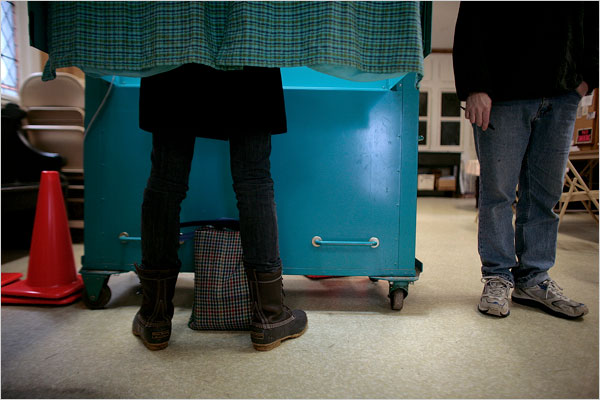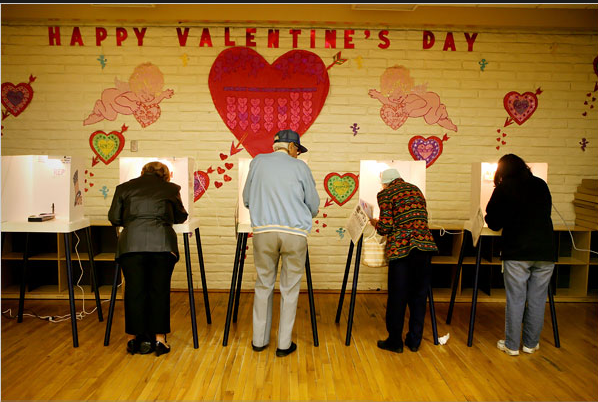The Super Tuesday elections were reported yesterday with stories and graphics and victory celebration photos, and for once the hype may have been matched by the results and the good vibe. Perhaps the turnout will help the media move on from their theme of the week, which was fretting about the “arcane” primary process–as if monarchy would be more rational or bureaucracy more transparent. In any case, we all can take a breath, plug the answering machines back in, and get back to our less than super-sized routines. As one last look back, however, I’d like to put up a couple of images from the slide shows at the major papers that were part of yesterday’s coverage.The slides depict the considerable variety and common shabbiness of the places where America votes. Schools, churches, laundromats, garages, you name it–we haven’t moved up much from the days when Americans voted in taverns. Any one of the slides would do, but this one caught my eye for several reasons:
By cropping the photo to feature people from the waist down, the trope of metonymy is put in play. John and I write about this focus on “boots and hands” from time to time because, first, such images are everywhere despite their individual peculiarity, and, second, they push forward a particular idea of the body politic. This image is a case in point: voters are known by their anonymity but assumed to have walked the walk and taken a stand on behalf of the polity. They are inherently fragmentary and so needing to be aggregated, but also inevitably plural and otherwise part of a society in which their are many walks of life. (If you don’t like cliches, even when used to make a point, this is not your day.)
The photograph elaborates this conception of democracy. By cutting out the markers of personality, we are left with a social scene and social types. The scene is totally functional: voting machine with wheels and handles for being moved in and out of storage, bare floor, warning pylons for when the floor is being washed, folding chairs and tables in the background. This is never going to be a personal, intimate place but rather a place where people congregate to do something in common. The clothes of the two figures take it a step further: jeans, dark coats, boots or worn shoes, these are the clothes of the mythical common man. She is a bit more stylish, he compensates for that. Their clothes are unconsciously coordinated with each other, as is her bag with the cloth on the voting booth. The only really garish color is the weird aquamarine of the machine, as if it were something for a party, which it is.
This last suggestion that democracy is somehow both routine and festive is taken a step further in the second photo.
Again we have a functional scene–the wood floor and brick wall of a recreational center–and a social type–the elderly. There also is the visual irony, which contrasts the seriousness of voting with the frivolous decor of a holiday, and the bent postures of old age with the frizzy excessiveness of young love. The visual grammar places the elderly in the space of the real, with the decorations in the place of the ideal. Their complete lack of attention to the decorations makes it seem that whatever cupid symbolizes, its completely irrelevant to the preoccupations of old age.
There is a third contrast as well. I doubt that those in the picture are oblivious to either romance or decorative arts, but they are paying attention to their ballots. Thus, the photograph depicts not only youth and age but also romantic love and love of country. The photograph’s ironies are superficial but pose an interesting question: Can one have two loves? This is a fundamental question in a liberal-democratic society, where we regularly experience the tension between the right to a private life and the value of government by the people. The answer to the question is a choice. You can see the two loves as existing only side by side and ironically so, or you can see them as different but ultimately compatible. And on that question, the polls are always open.
Photograph by Nathaniel Brooks and Monica Almeida for The New York Times. The first was taken at Saint John the Evangelist church in Barrytown, New York, and the second at the Belvedere Park Recreation Center in East Lost Angeles, California.


Good choices. I think there is a bit of an age component on the first photo as well (judging from the hands of the person on the right and the posture of the person on the left) that suggests multiple generations participating. I also would never have guessed that it was in a church. And the orange cones are interesting for the context (and are the only different color) as they seem to suggest some rule or organization in a space that doesn’t look especially organized for this event.
[…] NO CAPTION NEEDED created an interesting post today on My Vote, My ValentineHere’s a short outline […]